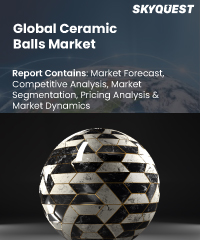
Report ID: SQMIG15O2024

Report ID:
SQMIG15O2024 |
Region:
Global |
Published Date: February, 2024
Pages:
157
|
Tables:
87 |
Figures:
76
Global Ceramic Ball Market size was valued at USD 11.55 billion in 2021 and is poised to grow from USD 12.71 billion in 2022 to USD 27.55 billion by 2030, at a CAGR of 10% during the forecast period (2023-2030).
The global ceramic ball market has witnessed significant growth in recent years, driven by the increasing demand from various industries such as automotive, chemical, aerospace, and healthcare. Ceramic balls, made from materials like alumina, zirconia, and silicon nitride, possess excellent properties such as high hardness, corrosion resistance, and thermal stability, making them suitable for a wide range of applications. One of the key drivers of growth is the expanding automotive industry. Ceramic balls are extensively used in automotive bearings, valves, and pumps due to their superior wear resistance and high-temperature capabilities. With the rising production and sales of vehicles worldwide, the demand for ceramic balls in the automotive sector is expected to remain robust. The chemical industry also plays a vital role in driving the ceramic ball market. Ceramic balls are utilized in chemical reactors, catalyst support, and grinding media applications. The growing demand for specialty chemicals and the need for efficient and reliable chemical processing equipment are fueling the demand for ceramic balls in this sector.
However, the ceramic ball market also faces several challenges. One of the primary challenges is the high cost of raw materials used in ceramic ball production. Materials like alumina and zirconia can be expensive, impacting the overall cost of manufacturing ceramic balls. This cost factor can limit the adoption of ceramic balls, especially in price-sensitive markets. Another challenge is the competition from alternative materials. While ceramic balls offer excellent properties, other materials like steel, plastic, and glass can also be used in certain applications. Manufacturers need to showcase the unique advantages of ceramic balls and emphasize their superior performance to overcome the competition from these alternatives. Furthermore, the ceramic ball market is susceptible to economic fluctuations and market uncertainties. Factors like trade disputes, political instability, and changing regulations can affect the overall demand and supply dynamics, impacting the growth of the market.
Our industry expert will work with you to provide you with customized data in a short amount of time.
REQUEST FREE CUSTOMIZATIONWant to customize this report? This report can be personalized according to your needs. Our analysts and industry experts will work directly with you to understand your requirements and provide you with customized data in a short amount of time. We offer $1000 worth of FREE customization at the time of purchase.

Report ID: SQMIG15O2024